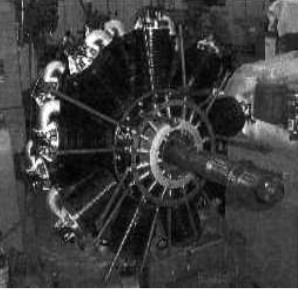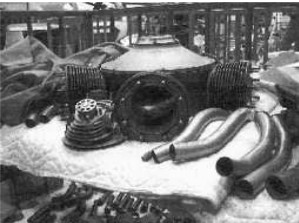Updated: 13-Oct-2020
The engine designed by G.O. Hodge (see Hodge) was an experimental, differential-rotary, air-cooled radial built by the New Britain Machine Company during WWI.
-The cylinders were made of steel with aluminum heads. It had 18 cylinders in two rows of 9 each.
-The compression ratio was 5: 1. The power was set at 320 HP and it weighed about 480 lbs.
-One of these engines is currently under restoration at the New England Air Museum.

"Hodge Engine at the New England Air Museum"
-Another engine built by the NBM was Angle's (see).

"Glen Angle's Engine at NEAM"
-The engine that G. Angle designed in 1939 in association with a group of Detroit inverters broke with the common design of other radials, being the crankcase and the cylinders in one piece.
-Construction agreements were made with the New Britain Machine Co. in addition to other Angle designs, until 1945.
-One of these Angle designs was an horizontally-opposed four-cylinder with more power than its contemporaries and less resistance (drag).
-Plans are still kept at NEAM.

“Restoration by museum volunteers”
-These three photographs belong to the NEAM Museum inventory.
Engines of NEW BRITAIN MACHINE
Model: Glen Angle, 5 cyl. radial
Arquitecture: 5-cylinder Radial
Cooling:
Total Displacement:
Bore / Stroke:
Power:
Weight:

"Glen Angle's engine at the NEAM"
Model: Hodge, 18 cyl. radial
Arquitecture: 18-cylinder Radial
Cooling:
Total Displacement:
Bore / Stroke:
Power:
Weight:

"Hodge engine at the New England Air Museum"


